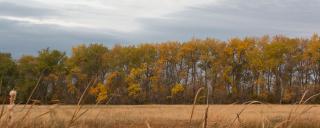
Woodland Habitats
The Game and Fish Department can cost-share on establishment, renovation and management of woodland habitats as well as pay a rental to protect these habitats. Access for walk-in hunting is required on most cost-share agreements. The PLOTS programs for cost-share and woodland protection include Habitat Plots, Working Lands and the Shrub and Tree Planting programs.
Woodland Habitat Introduction
Although known as a prairie state, North Dakota does have areas of native woodland. Historically, only 700,000 acres, or 1.5 percent of North Dakota, was considered forested. Today, forestland covers approximately 450,000 acres or 1 percent of North Dakota’s landscape. Fifty-five percent of the state’s forests are found in the Killdeer Mountains, Turtle Mountains, Pembina Hills and the Devils Lake area. The other largest concentrations of native forests exist as riparian forests along stream corridors, and Rocky Mountain juniper stands in the badlands. Approximately 43 percent of North Dakota forests are elm-ash, while 28 percent are aspen-dominated. Sixteen percent are dominated by oak, and 8 percent are dominated by cottonwood. Approximately 4,000 acres of ponderosa pine forest is located in extreme southwestern North Dakota. Many of the cottonwood-dominated forests along riparian zones of major rivers were established and maintained by periodic flooding. Dams built for flood control have killed cottonwood forests by direct flooding or by reducing natural flooding events needed for seedling recruitment. Trees and shrubs planted for windbreaks, shelterbelts and wildlife plantings have created another large woodland area in North Dakota. However, planted trees do not provide adequate habitat for woodland dependent species.
Restoration and Management of Woodland Habitats
Restoration of forestland will vary according to the forest type and location.
- Riparian forests: Plant native trees and shrubs along stream corridors in areas where woody vegetation has been removed or excessive grazing has diminished woody species. Avoid introducing invasive woody plants such as eastern red cedar and Russian olive. Consider how native riparian forests appeared on the landscape. Avoid introducing conifers – they are not native to riparian forests in North Dakota. Reintroducing cottonwoods and willows on flood-controlled riparian areas may be difficult due to lack of available water. Where seed trees are available, manage abandoned cropland fields and pastureland to maximize recruitment from nearby native cottonwoods, boxelder, willows, green ash and bur oak. Stands of Kentucky bluegrass, bromegrass or reed canary grass will need to be controlled prior to planting trees.
- Aspen forests: Aspen reintroduction can be accomplished in areas historically forested with aspen. Seedlings can be planted in blocks of 25 trees with 7-8 blocks/acre. Aspen will actively sucker 10-15 years after planting. Eliminate tillage adjacent to aspen forests, allowing aspen to spread by suckering. Mature stands of aspen greater than 60 years old need management by shearing or timber harvest to stimulate new growth. Aspen stands of various ages are especially important in maintaining ruffed grouse populations.
- Other forest types: Expand existing forests by planting a diversity of native trees and shrubs adjacent to existing forests. Match tree and shrub species with adjacent woodland type. Mix species within the row to achieve a more natural restoration. In areas with an adequate seed source, plant the adjacent field to a mixture of sideoats grama (1.5 lbs./acre), big bluestem (1.5 lbs./acre) and Canada wild rye (2 lbs./acre). This grass mixture will colonize the site, but will leave enough bare mineral soil and sunlight penetration for tree and shrub seeds to germinate.
- Avoid season-long grazing in any woodland type.
- Graze woodlands when targeted understory grass species are most palatable.
- Cool-season grasses need to be grazed in spring and early summer while warm-season grasses need to be grazed in mid–to-late summer.
- Avoid grazing when trees and shrubs are most attractive to cattle.
Establishment of Woodland Habitats
- When establishing woodland habitat, always consider fragmentation to grassland dependent wildlife.
- Avoid planting invasive woody species adjacent to native riparian forests.
- Limit shelterbelt-type planting to previously disturbed areas such as cropland. Planting trees in or near herbaceous vegetation, native or introduced, negatively affects grassland nesting birds such as waterfowl, pheasants, sharp-tailed grouse and many grassland passerines. Linear shelterbelt-type plantings provide opportunities for nest-parasitic species such as brown-headed cowbirds, and provide predator corridors for predators such as raccoons, skunks and crows.
- Linear-type shelterbelt plantings of 1-8 rows do not provide the necessary habitat for forest species, nor do they provide effective winter cover for other wildlife species. Any shelterbelt-type planting for wildlife needs to be as wide as possible to provide adequate woodland habitat benefits.
- Do not use weed control fabric on suckering shrubs. Weed control fabric inhibits the spread of most suckering shrubs, reducing wildlife benefits, especially thermal cover.
- Consider removing woody habitat near pheasant nesting habitat and sharp-tailed grouse dancing grounds. Pheasant nesting success is lower next to, and within, shelterbelts. Sharp-tailed grouse also have a negative association with trees.
